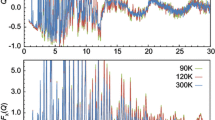Abstract
A powder neutron diffraction study of ussingite, Na2AlSi3O8(OH), over the temperature range 4–850 K has been undertaken. The strong hydrogen bond that exists in this mineral has been accurately determined with the O–H distance at 1.070(8) Å and an O(donor)–O(acceptor) separation of 2.481(5) Å at 4 K, The distribution of hydrogen along the O–O direction remains asymmetric between 4 and 850 K with the H atom being fully ordered at a single site, rather than partially disordered over two sites of a double-potential well, as in serandite. A gradual increase in the bonded O–H distance at higher temperatures is observed, indicative of a broadening of the potential well in which the hydrogen atom is sited. Below 50 K, the material shows negative thermal expansion, likely to be associated with reduced bending motion of the O–H bond.







Similar content being viewed by others
References
Armstrong JA, Friis H, Lieb A, Finch AA, Weller MT (2010) Combined single-crystal X-ray and neutron powder diffraction structure analysis exemplified through full structure determinations of framework and layer beryllate minerals. Am Mineral 95:519–526
Attfield MP, Sleight AW (1998) Strong negative thermal expansion in siliceous faujasite. Chem Commun 5:601–602
Barrie PJ, Gladden LF, Klinowski J (1991) Neutron-diffraction studies of realuminated zeolite-y. J Chem Soc Chem Commun 8:592–594
Bell DR, Rossman GR (1992) Water in earths mantle—the role of nominally anhydrous minerals. Science 255:1391–1397
Berry AJ, James M (2002) Refinement of hydrogen positions in natural chondrodite by powder neutron diffraction: implications for the stability of humite minerals. Mineral Mag 66:441–449
Bøggild O (1914) Ussingit, ein neues Mineral von Kangerdluarsuk. Z Kristallogr 54:120–126
Burns PC, Hawthorne FC (1994) Structure and hydrogen-bonding in preobrazhenskite, a complex heteropolyhedral borate. Can Mineral 32:387–396
Busing W, Levy H (1964) The effect of thermal motion on the estimation of bond lengths from diffraction measurements. Acta Crystallogr 17:142–146
Engell J, Hansen J, Jensen M, Kunzendorf H, Lovborg L (1971) Beryllium mineralization in the Ilímaussaq intrusion, South Greenland, with description of a field beryllometer and chemical methods. Rapp Grønl Geol Unders 33:1–40
Farver JR, Yund RA (1990) The effect of hydrogen, oxygen, and water fugacity on oxygen diffusion in alkali feldspar. Geochim Cosmochim Acta 54:2953–2964
Hewat AW, Heathman S (1984) D2B, a new high-resolution neutron powder diffractometer. Acta Crystallogr Sect A 40:C364–C364
Ilyukin V, Semenov Y (1959) New data on ussingite. Dokl Earth Sci 129:1176–1178
Jacobsen SD, Smyth JR, Swope RJ, Sheldon RI (2000) Two proton positions in the very strong hydrogen bond of serandite, NaMn2·Si3O8(OH). Am Mineral 85:745–752
Johnson EA, Rossman GR (2004) An infrared and H-1 MAS NMR investigation of strong hydrogen bonding in ussingite, Na2AlSi3O8(OH). Phys Chem Miner 31:115–121
Kotel’nikov AR, Ogorodova LP, Mel’chakova LV, Vigasina MF (2010) Ussingite from the Lovozero Alkaline Massif: calorimetric, thermal, and ir spectroscopic study. Geochem Int 48:183–186
Larson AC, Von Dreele RB (1994) General structure analysis system (GSAS), Los Alamos National Laboratory Report LAUR 86-748
Libowitzky E (1999) Correlation of O–H stretching frequencies and O–H center dot center dot center dot O hydrogen bond lengths in minerals. Monatsh Chem 130:1047–1059
Lightfoot P, Woodcock DA, Maple MJ, Villaescusa LA, Wright PA (2001) The widespread occurrence of negative thermal expansion in zeolites. J Mater Chem 11:212–216
Mandarino J, Anderson V (1989) Motneregian treasures: the minerals of Mont Saint-Hilaire. Cambridge University Press, Quebec, p 207
Miyoshi T, Mashiyama H, Asahi T, Kimura H, Noda Y (2011) Single-crystal neutron structural analyses of potassium dihydrogen phosphate and potassium dideuterium phosphate. J Phys Soc Jpn 80:044709-1–10
Novak A (1974): Hydrogen bonding in solids. Correlation of spectroscopic and crystallographic data. Struct Bond 18:177–216
Nyfeler D, Armbruster T (1998) Silanol groups in minerals and inorganic compounds. Am Mineral 83:119–125
Oglesby JV, Stebbins JF (2000) Si-29 CPMAS NMR investigations of silanol-group minerals and hydrous aluminosilicate glasses. Am Mineral 85:722–731
Rietveld HM (1969) A profile refinement method for nuclear and magnetic structures. J Appl Crystallogr 2:65–71
Rossi G, Tazzoli V, Ungaretti L (1974) Crystal-structure of ussingite. Am Mineral 59:335–340
Tanaka H (2001) Hydrogen bonds between water molecules: thermal expansivity of ice and water. J Mol Liq 90:323–332
Toby BH (2001) EXPGUI, a graphical user interface for GSAS. J Appl Crystallogr 34:210–213
Weller MT, Henry PF, Ting VP, Wilson CC (2009) Crystallography of hydrogen-containing compounds: realizing the potential of neutron powder diffraction. Chem Commun 21:2973–2989
Woodcock DA, Lightfoot P, Villaescusa LA, Diaz-Cabanas MJ, Camblor MA, Engberg D (1999) Negative thermal expansion in the siliceous zeolites chabazite and ITQ-4: A neutron powder diffraction study. Chem Mater 11:2508–2514
Acknowledgments
This research was supported by the EPSRC (EP/G068038/1). We also thank ILL for the provision of neutron beam time under proposal 5-21-1025.
Author information
Authors and Affiliations
Corresponding author
Rights and permissions
About this article
Cite this article
Williams, E.R., Weller, M.T. A variable-temperature neutron diffraction study of ussingite; a strong asymmetric hydrogen bond in an aluminosilicate framework. Phys Chem Minerals 39, 471–478 (2012). https://doi.org/10.1007/s00269-012-0501-4
Received:
Accepted:
Published:
Issue Date:
DOI: https://doi.org/10.1007/s00269-012-0501-4




